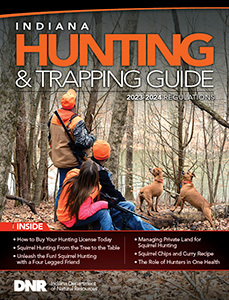Game Birds
Pheasant
Pheasant season is from Nov. 1 - Dec. 15. A valid hunting license and Indiana Game Bird Habitat Stamp are required to hunt pheasants. Hunter orange clothing requirements (General Information: Hunter Orange Requirements) must be met while hunting pheasants. The daily bag limit for pheasants is two male (cock) pheasants.
It is illegal to shoot female pheasants (hens), except during put-and-take hunts in designated areas. If you take a pheasant, you must leave the head and head plumage attached while you are transporting the bird. There are no equipment or ammunition restrictions for pheasant hunting. A 12- or 20-gauge shotgun loaded with 4- to 6-size shot is recommended. Non-toxic shot is required when hunting pheasant on some DNR properties. Call the property for additional information.
Put-and-Take
Pheasants are released for put-and-take hunting on Atterbury, Glendale, J. E. Roush Lake, Pigeon River, Tri-County, Willow Slough, and Winamac FWAs. Put-and-take pheasant hunting on these DNR properties starts on November 18, 2023.
There is a per-person fee to participate in put-and-take hunts. The bag limit for put-and-take pheasant hunting is two birds of either sex , except at Pigeon River, Willow Slough, and Winamac FWAs, where the limit is two roosters only. A hunter filling their limit in the put-and-take hunt may not take any more pheasants that day.
When applications are being accepted, hunters can reserve put-and-take pheasant hunts online at hunting.IN.gov. Hunts are no longer available first-come, first-served at the property.
Hunters can select the date, property, and area for their hunt.
Pheasant hunters in designated put-and-take areas are prohibited from harvesting game animals other than pheasants on days when pheasants are released and hunted. This restriction is only for pheasant hunters and only in their designated units.
Game Bird Areas
The Division of Fish & Wildlife conducts reserved pheasant hunts on Game Bird Areas in northern Indiana (Benton, Jasper, Newton, Warren, and White counties). When the application period is open, hunters can apply at hunting.IN.gov.
Quail
Quail hunting is divided into two zones — north and south. Interstate 74 is the dividing line.
The North Zone season is from Nov. 1 to Dec. 15, with a bag limit of four birds. The South Zone season is from Nov. 1 to Jan. 10, with a bag limit of eight birds.
The daily bag limit at North Zone Fish & Wildlife areas and at Mississinewa Lake and Salamonie Lake is two quail. The daily bag limit at South Zone Fish & Wildlife areas and at Patoka Lake is four quail.
A valid hunting license and an Indiana Game Bird Habitat Stamp are required to hunt quail in Indiana. Hunter orange clothing requirements (General Information) must be met while hunting quail.
There are no equipment or ammunition restrictions for quail hunting. A 12- or 20-gauge shotgun loaded with 6- to 9-size shot is recommended.
Some DNR properties may have additional regulations for quail hunting. Check with the property for details (Public Hunting Areas).
Other Wild Birds
English sparrows, European starlings, monk parakeets, and feral pigeons (except homing pigeons) may be killed at any time.
Brown-headed cowbirds, common grackles, red-winged blackbirds, Brewer’s blackbirds and crows may be controlled without a permit when they are damaging trees or crops or creating a public health hazard in accordance with federal regulations. All other nongame species of birds not otherwise covered in this regulation are protected by state or federal law and may not be killed. These provisions do not override any local ordinances restricting the use of firearms and other equipment.
Crow
Crow hunting season is July 1 - Aug. 15 and Dec. 13 - March 1.
Crows may be taken outside of the hunting season only if they are damaging trees, crops, livestock or wildlife, or creating a public health hazard. There are no restrictions on use of calls or decoys, and crows may be taken with bow and arrow, crossbow, or firearm in accordance with local ordinances.
You are not required to have a state stamp, federal stamp, or HIP registration number to hunt crows.

